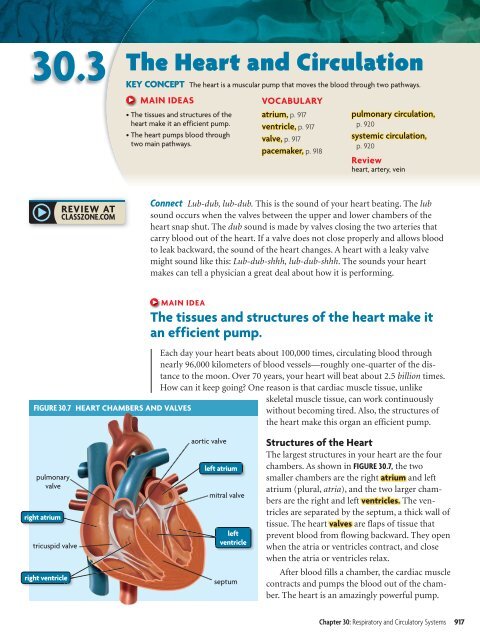30 Respiratory and Circulatory Systems
30 Respiratory and Circulatory Systems
30 Respiratory and Circulatory Systems
Create successful ePaper yourself
Turn your PDF publications into a flip-book with our unique Google optimized e-Paper software.
<strong>30</strong>.3<br />
The Heart <strong>and</strong> Circulation<br />
KEY CONCEPT The heart is a muscular pump that moves the blood through two pathways.<br />
MAIN IDEAS<br />
• The tissues <strong>and</strong> structures of the<br />
heart make it an efficient pump.<br />
• The heart pumps blood through<br />
two main pathways.<br />
VOCABULARY<br />
atrium, p. 917<br />
ventricle, p. 917<br />
valve, p. 917<br />
pacemaker, p. 918<br />
pulmonary circulation,<br />
p. 920<br />
systemic circulation,<br />
p. 920<br />
Review<br />
heart, artery, vein<br />
Connect Lub-dub, lub-dub. This is the sound of your heart beating. The lub<br />
sound occurs when the valves between the upper <strong>and</strong> lower chambers of the<br />
heart snap shut. The dub sound is made by valves closing the two arteries that<br />
carry blood out of the heart. If a valve does not close properly <strong>and</strong> allows blood<br />
to leak backward, the sound of the heart changes. A heart with a leaky valve<br />
might sound like this: Lub-dub-shhh, lub-dub-shhh. The sounds your heart<br />
makes can tell a physician a great deal about how it is performing.<br />
MAIN IDEA<br />
The tissues <strong>and</strong> structures of the heart make it<br />
an efficient pump.<br />
Each day your heart beats about 100,000 times, circulating blood through<br />
nearly 96,000 kilometers of blood vessels—roughly one-quarter of the distance<br />
to the moon. Over 70 years, your heart will beat about 2.5 billion times.<br />
How can it keep going One reason is that cardiac muscle tissue, unlike<br />
skeletal muscle tissue, can work continuously<br />
FIGURE <strong>30</strong>.7 HEART CHAMBERS AND VALVES<br />
without becoming tired. Also, the structures of<br />
the heart make this organ an efficient pump.<br />
pulmonary<br />
valve<br />
right atrium<br />
tricuspid valve<br />
right ventricle<br />
aortic valve<br />
left atrium<br />
mitral valve<br />
left<br />
ventricle<br />
septum<br />
Structures of the Heart<br />
The largest structures in your heart are the four<br />
chambers. As shown in FIGURE <strong>30</strong>.7, the two<br />
smaller chambers are the right atrium <strong>and</strong> left<br />
atrium (plural, atria), <strong>and</strong> the two larger chambers<br />
are the right <strong>and</strong> left ventricles. The ventricles<br />
are separated by the septum, a thick wall of<br />
tissue. The heart valves are flaps of tissue that<br />
prevent blood from flowing backward. They open<br />
when the atria or ventricles contract, <strong>and</strong> close<br />
when the atria or ventricles relax.<br />
After blood fills a chamber, the cardiac muscle<br />
contracts <strong>and</strong> pumps the blood out of the chamber.<br />
The heart is an amazingly powerful pump.<br />
Chapter <strong>30</strong>: <strong>Respiratory</strong> <strong>and</strong> <strong>Circulatory</strong> <strong>Systems</strong> 917

















